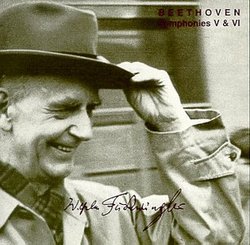| All Artists: Ludwig van Beethoven, Wilhelm Furtwängler, Berliner Philharmoniker, Berlin Philharmonic Orchestra Title: Beethoven: Symphonies No. 5, 'Fate,' and No. 6, 'Pastorale' (Furtwangler's Volcanic First Post-War Concert, 25 May 1947) Members Wishing: 0 Total Copies: 0 Label: Music & Arts Programs of America Release Date: 1/31/1995 Genre: Classical Styles: Historical Periods, Classical (c.1770-1830), Modern, 20th, & 21st Century, Symphonies Number of Discs: 1 SwapaCD Credits: 1 UPC: 017685078927 |
Search - Ludwig van Beethoven, Wilhelm Furtwängler, Berliner Philharmoniker :: Beethoven: Symphonies No. 5, 'Fate,' and No. 6, 'Pastorale' (Furtwangler's Volcanic First Post-War Concert, 25 May 1947)
 | Ludwig van Beethoven, Wilhelm Furtwängler, Berliner Philharmoniker Beethoven: Symphonies No. 5, 'Fate,' and No. 6, 'Pastorale' (Furtwangler's Volcanic First Post-War Concert, 25 May 1947) Genre: Classical
Wilhelm Furtwängler's dynamic, always-evolving--even unpredictable--interpretations of a classic score could overwhelm with their paradoxical aura of inevitability. This is perhaps most dramatically the case with the ... more » |
Larger Image |
CD Details
Synopsis
Amazon.com essential recording
Wilhelm Furtwängler's dynamic, always-evolving--even unpredictable--interpretations of a classic score could overwhelm with their paradoxical aura of inevitability. This is perhaps most dramatically the case with the conductor's performances of Beethoven. The occasion of the live accounts on this disc--from a concert on May 25, 1947, Furtwängler's first reunion with the Berlin Philharmonic after his name had been cleared in denazification trials--was already highly charged from the outset. Despite some moments of ragged ensemble in the Fifth (note the train wreck of the tutti 29 seconds in), Furtwängler's control of tension--the opening motif is a tightly coiled spring--and organic sense of structure allow the music to flex its muscle, contracting and expanding with riveting intensity. Victory emerges in the finale not only with musical logic but with moral conviction. The drawn-out fermatas Furtwängler opts for have an oceanic depth and are in their own way emblematic of his style of conducting such music of concentrated drama. All the more extraordinary to hear the Fifth followed by Furtwängler's gloriously expansive, relaxed "Pastoral": the two symphonies, side by side, suggest a yin-and-yang totality to Beethoven's creativity. Furtwängler scoops, molds, caresses, and delineates musical contours through his famous tempo fluctuations. His grasp of longer phrases and paragraphs meshes generously with the pantheistic implications of the score. These interpretations don't yield up their secrets with one hearing but promise new insights each time they're revisited. --Thomas May

 Track Listings (6) - Disc #1
Track Listings (6) - Disc #1